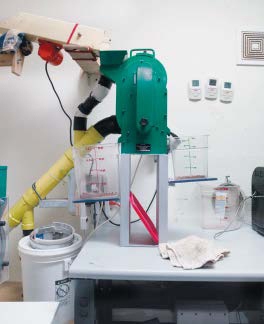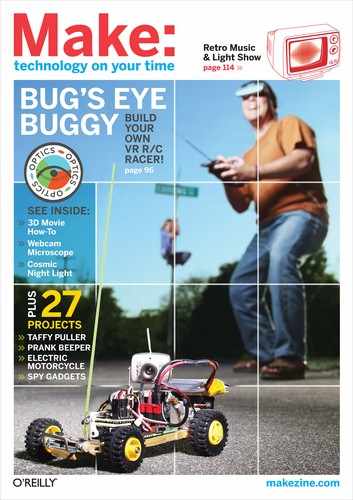PROTO: Timothy and the Chocolate Factory
How a space shuttle technologist and the founder of Wired magazine hacked together a homebrew chocolate lab.
VISITING TCHO IS THE MAKER’S EQUIVALENT of winning one of Willy Wonka’s Golden Tickets. The new chocolate company, headquartered in a vast warehouse on San Francisco’s Pier 17, is a sweet blend of DIY ingenuity, self-taught science, and online community. From hacking together a homebrew chocolate lab for $5,000 instead of buying a $100,000 “pro” system, to tricking out a 30-year-old chocolate factory line shipped over from Germany, TCHO (tcho.com) embodies a maker mindset that its founder calls “scrappy not crappy.”
“I was a technologist working on things like the space shuttle when I got seduced by this weird, crystalline, alien goo that’s called chocolate,” says TCHO co-founder Timothy Childs.
TCHO, pronounced “cho,” bills itself as a company “where technology meets chocolate, where Silicon Valley meets San Francisco food culture.” Appropriately enough, then, the chocolate is still in beta. Fifty-gram bars in plain brown wrappers are available for $5 with formulations subject to change as often as every few days, incorporating direct feedback from, er, users. In the next year or so, though, the company plans to transform part of its warehouse into a retail store and European-style tasting room.
Childs’ eventual goal is to see TCHO chocolate become an in-demand ingredient in other companies’ products. His business plan is based on using the web to transform the supply chain into a supply loop. TCHO will use digital video and other media to tell the chocolate’s life story, opening the lines of communication between, say, the Peruvian farmer who grew a particular bean and the customer on another continent. The entire manufacturing process will be transparent, he explains, from cacao pod to palette, and TCHO will be the hub of communication between supplier and sweet tooth.
The first step, though, is getting the factory line up and running. Matthew Heckert, a kinetic artist and alum of machine performance group Survival Research Laboratories, is leading the restoration of vats, tanks, mixers, and refiners that have been dry for years. The story of how the 1972-vintage factory line made its way to San Francisco is part of the whole TCHO creation myth.
In 2003, Childs, a veteran technologist, was working on a NASA contract to develop machine vision technology for the space shuttle. Around the same time, a friend at a previous tech startup had prophesied to Childs that premium, single-origin dark chocolate was the next big thing for foodies. Through a bit of kitchen chemistry, the friend had engineered dark chocolate to melt in your mouth. Childs was intrigued by the business possibilities.
Then, with the explosion of the shuttle Columbia on February 1, he suddenly had a lot more free time. Based on the new technique, Childs and his friend co-founded a confection company called Cabaret Chocolates. For production, they secured an old Oakland chocolate factory filled with obsolete, broken machines. During the day Childs repaired the machines, and at night he evangelized Cabaret at dot-com parties.
“I learned about how chocolate was made by fixing those machines,” he says. “We had very limited investment, so we had to invent our own centrifuges

HOMEBREW CHOCOLATE: Timothy Childs (right) and Matt Heckert on the factory floor. Behind them is a conch and McIntyre refiner. Roxie, at lower right, is Timothy’s dog and the company mascot. And no, Roxie doesn’t risk her life sampling the product.
“We’re virtualizing the whole control system so it can be operated from a single touchscreen. Eventually, I’ll be able to run the factory from my iPhone.”
and texture enhancement systems.”
Childs’ idea was to launch a line of premium chocolate to complement Cabaret’s confections. When he realized the company wasn’t moving in that direction, he set out alone. For months he immersed himself in chocolate, eventually finding himself at Interpak, the process and packaging machine fair in Germany where the candy industry converges every three years. There he met a “grizzled old chocolate expert,” as he describes his adviser and eventual business partner (who prefers not to be named).
Shortly thereafter, this expert called Childs with news of a bargain. He was appraising a decommissioned East German chocolate factory that was selling off its top-notch but dated gear. Childs had to act quickly. He rang his old friend Louis Rossetto, the founder of Wired magazine and a Cabaret fan, and asked for a loan. Oddly enough, it was a perfect fit.
“Chocolate is a traditional food, but it’s also very modern,” says Rossetto, now the company’s CEO and creative director. “TCHO isn’t just selling chocolate but rather the whole chocolate experience. People want their products to tell stories and chocolate is the media for this story.”
Once Heckert’s team completes some repairs on the equipment, the line will be outfitted with the latest in digital sensors and video cameras. The sensors measure temperatures, monitor valves, and check for blockages while the cameras allow fewer people to operate the factory. The factory’s original bureau-sized control panel, something that might belong on the Starship Enterprise’s bridge, is now a conversation piece in TCHO’s reception area.
“We’re virtualizing the whole control system so it can be operated from a single touchscreen,” Childs says. “Eventually, I’ll be able to run the factory from my iPhone.”
In the meantime, Childs is gearing up the business operations and sampling ingredients. Not a bad job, except when the future of your business is hanging on your taste buds. Childs is like a sommelier of confections. In fact, his passion for wine predated his fascination with chocolate and directly inspired how he and Rossetto think about TCHO’s product. “Timothy developed a new taxonomy for chocolate,” Rossetto says.
Today, most premium chocolate is classified by region or by percentage, referring to the mass of cacao bean (cocoa) in the bar compared to flavorings like sugar or vanilla. The problem, Childs explains, is that percentages aren’t a true gauge of flavor. Different beans can be coaxed to yield various flavors by adding more or less sugar or tweaking the manufacturing process, so two bars may have similar percentages of cocoa mass in them, but taste quite different. Classifying by origin is equally problematic because most regions offer many different flavors of beans.
“Wine has similar descriptors as chocolate,” Childs says. “So I decided to use six base-level, building-block flavors to classify our chocolate, like fruity, nutty, and, of course, chocolatey.” The TCHO Flavor Profile acts as a road map to define the types of beans he seeks in South America and elsewhere. Once Childs connects with a farmer, he heads back to the lab to put some of their beans through their paces (see “From Pod to Palette,” page 32).
TCHO is slowly outfitting the chocolate lab with industry-standard equipment, but the company was launched with scavenged gear hacked together with duct tape and glue. It wasn’t pretty, but it worked. And it served as a prototype. TCHO’s plan is to help farmers build their own similar labs.
“Most independent farmers have never tasted chocolate from their own beans,” Childs says. Providing farmers with tools to improve their product, he explains, will help them shift from producers of commodity beans to premium growers. And that can only lead to better chocolate for everyone.
“TCHO,” he says, “is really a tool to reshape how premium chocolate is made and experienced.”
David Pescovitz is editor at large of MAKE.

A converted and customized coffee bean roaster works like a champ for cacao.

The Crankenstein is a grinder for beer hops, customized with a wider gap between the rollers for cocoa beans to fit through.

After it’s ground, winnowers are used to blow off the bean’s shell from the meat. Childs modified plans he found online for a winnower designed for agricultural use in developing nations. They cobbled together a spare blower from Heckert’s shop using a Shop-Vac found on a sidewalk, and made a vibrating feeder using a vibrator from another old machine. After adding some PVC pipe, the total cost was $12.


These wet mixers, now used as chocolate melangers, were made to mix Indian curries. Temperature control is essential when making chocolate, so Heckert took Childs’ design and outfitted the mixers with infrared sensors and cheap space heaters that blow just the right amount of hot air on the oozing goodness.

CLOCKWISE FROM TOP LEFT: In the hot room, chocolate is poured and molded by hand. Adjacent to the hot room is the cool room, where the bars are demolded. Stackable bins hold a variety of chocolate samples that are bagged and labeled by batch.
![]() For an online photo gallery of TCHO’s chocolate factory, see makezine.com/14/proto.
For an online photo gallery of TCHO’s chocolate factory, see makezine.com/14/proto.

